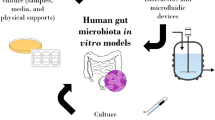Abstract
A combined stochastic-deterministic model able to predict the growth curve of microorganisms, from inoculation to death, is presented. The proposed model is based on the assumption that microorganisms can experience two different physiological states: non-proliferating and proliferating. The former being the physiological state of the cells right after their inoculation into the new extracellular environment; the latter the state of microorganisms after adaptation to the new medium. To validate the model, a Lactobacillus bulgaricus strain was tested in a medium at pH 4.6 at two different temperatures (42°C and 35°C). Curves representing the bacterial growth cycle were satisfactorily fitted by means of the proposed model. Moreover, due to the mechanistic structure of the proposed model, valuable quantitative information on the following was obtained: rate of conversion of non-proliferating cells into proliferating cells, growth and death rate of proliferating cells, and rate of nutrient consumption.








Similar content being viewed by others
References
Bailey JE, Ollis DF (1986) Biochemical engineering fundamentals, 2nd edn. McGraw-Hill, New York
Baranyi J (1998) Comparison of stochastic and deterministic concepts of bacterial lag. J Theor Biol 192:403–408
Baranyi J, Roberts TA (1994) A dynamic approach to predicting bacterial growth in food. Int J Food Microbiol 23:277–294
Baranyi J, Roberts TA (1995) Mathematics of predictive food microbiology. Int J Food Microbiol 26:199–218
Baranyi J, Roberts TA, McClure P (1993) Some properties of a nonautonomous deterministic growth model describing the adjustment of the bacterial population to a new environment. J Math Appl Med Biol 10:293–299
Baranyi J, Roberts TA, McClure P (1993) A non-autonomous differential equation to model bacterial growth. Food Microbiol 10:43–59
Baranyi J, Walker JC, Kaloti A, Robinson TP, Mackey BM (1996) A combined model for growth and subsequent thermal inactivation of Brochothrix thermosphacta. Appl Environ Microbiol 62:1029–1035
Boquet R, Chirifie J, Iglesias HA (1978) Equations for fitting water sorption isotherms of foods. II. Evaluation of various two-parameters models. J Food Technol 13:319–327
Havenaar R, Huis A, Veld JHJ (1992) Probiotics: a general view. In: Wood B (ed) The lactic acid bacteria in health and disease. Elsevier, Barking, pp 151–170
Kato I, Endo K, Yokokura T (1994) Effects of oral administration of Lactobacillus casei on antitumor responses induced by tumor resection in mice. Int J Immunopharmacol 16:29–36
Mandel J (1964) The statistical analysis of experimental data. Interscience, New York
Press WH, Flannery BP, Teukolsky SA, Vetterling WT (1989) Numerical recipes in Pascal. University Press, Cambridge, pp 602–607
Pruitt KM, Kamau DN (1993) Mathematical models of bacterial growth, inhibition and death under combined stress conditions. J Ind Microbiol 12:221–231
Saxelin M (1996) Colonization of the human gastrointestinal tract by probiotic bacteria. Nutr Today 31:5S
Saxelin M, Rautelin H, Salminen S, Makela H (1996) The safety of commercial products with viable Lactobacillus strains. Infect Dis Clin Prac 5:331–335
Schiffrin EJ, Brassart D, Servin AL, Rochat F, Donnet-Huges A (1996) Immune modulation of blood leukocytes in man by lactic acid bacteria. Criteria for strain selection. Am J Clin Nutr 78:491–497
Skinner GE, Larkin JW, Rhodehamel EJ (1994) Mathematical modeling of microbial growth: a review. J Food Saf 14:175–217
Srivastava AK, Volesky B (1990) Characterization of transient cultures of Clostridium acetobutylicum. Biotechnol Prog 6:408–420
Tannock J (1999) Probiotics: a critical review. Horizon Scientific Press, Norfolk
Turner ME, Pruitt KM (1978) A common basis for survival, growth and autocatalysis. Math Biosci 39:113–123
Turner ME, Bradley ER, Kirk KA, Pruitt KM (1976) A theory of growth. Math Biosci 29:367–373
Whiting RC, Cygnarowicz-Provost M (1992) A quantitative model for bacterial growth and decline. Food Microbiol 9:269–277
Author information
Authors and Affiliations
Corresponding author
List of symbols
List of symbols
- \( {\left. {{{{\rm{d}}N{\left( t \right)}} \over {{\rm{d}}t}}} \right|^{{\max }} } \) :
-
the maximum of \( {{{\rm{d}}N\left( t \right)} \over {{\rm{d}}t}} \)
- E%:
-
the relative percent difference between experimental and predicted values
- F(t):
-
the limiting nutrient concentration in the extracellular environment (expressed as g/l) at time t
- F 0 :
-
the initial concentration of limiting nutrient in the extracellular environment (expressed as g/l)
- G(t):
-
the concentration of generated cells (expressed as cfu ml−1) at time t
- k i :
-
constant(s), to be regarded as fitting parameters
- m :
-
mean value of the probability density function
- M(t):
-
the concentration of death cells (expressed as cfu ml−1) at time t
- n exp :
-
the number of experimental data points
- N(t):
-
the microorganism concentration (expressed as cfu ml−1) at time t
- N 0 :
-
the initial concentration of microorganisms (expressed as cfu ml−1)
- P(t):
-
the concentration of proliferating microorganisms (expressed as cfu ml−1) at time t
- Q(t):
-
the concentration of non-proliferating cells (expressed as cfu ml−1) at time t
- Q 0 :
-
initial concentration of non-proliferating cells
- R 1(t):
-
probability density function of conversion of non-proliferating cells to proliferating cells (expressed as cfu ml−1 h−1)
- R 2(t):
-
the proliferation rate (expressed as cfu ml−1 h−1) at time t
- \( R_2^{\max } \) :
-
the maximum of R 2(t) (expressed as cfu ml−1 h−1)
- R 3(t):
-
the death rate (expressed as cfu ml−1 h−1) at time t
- \( Y_{\exp }^{\rm{i}} \) :
-
the experimental value
- \( Y_{{\rm{pred}}}^{\rm{i}} \) :
-
the predicted value
- σ:
-
standard deviation of the probability density function
Rights and permissions
About this article
Cite this article
Del Nobile, M.A., Altieri, C., Corbo, M.R. et al. Development of a structured model for batch cultures of lactic acid bacteria. J IND MICROBIOL BIOTECHNOL 30, 421–426 (2003). https://doi.org/10.1007/s10295-003-0066-9
Received:
Accepted:
Published:
Issue Date:
DOI: https://doi.org/10.1007/s10295-003-0066-9




